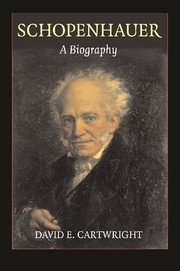Book contents
- Frontmatter
- Contents
- Preface
- Acknowledgments
- Notes on the Text
- Chronology of Schopenhauer's Life and Works
- 1 The Affirmation of the Will
- 2 A Tour for a Trade
- 3 A Father's Death; A Philosopher's Birth
- 4 The University Years
- 5 The Better Consciousness, Causes, Grounds, and Confrontations
- 6 Goethe, Colors, and Eastern Lights
- 7 The Single Thought of Dresden
- 8 Failure in Berlin
- 9 Ich Bin Kein Berliner
- 10 The Frankfurt Philosopher
- 11 The Dawn of Fame and the End of Life
- Works Cited
- Index
6 - Goethe, Colors, and Eastern Lights
Published online by Cambridge University Press: 05 April 2014
- Frontmatter
- Contents
- Preface
- Acknowledgments
- Notes on the Text
- Chronology of Schopenhauer's Life and Works
- 1 The Affirmation of the Will
- 2 A Tour for a Trade
- 3 A Father's Death; A Philosopher's Birth
- 4 The University Years
- 5 The Better Consciousness, Causes, Grounds, and Confrontations
- 6 Goethe, Colors, and Eastern Lights
- 7 The Single Thought of Dresden
- 8 Failure in Berlin
- 9 Ich Bin Kein Berliner
- 10 The Frankfurt Philosopher
- 11 The Dawn of Fame and the End of Life
- Works Cited
- Index
Summary
Schopenhauer's tumultuous family life during the six months when he lived in his mother's home in Weimar was counterpoised by two events that would become monumental in the philosopher's life. The first was his breaking into Goethe's orbit, an event for which he had longed and that he had engineered, in part, by sending the poet his dissertation. The second was his introduction to Eastern thought, which was a matter of pure serendipity. In his curriculum vitae, Schopenhauer wrote of Goethe's honoring him with his friendship and intimate acquaintance, “which I count as the most delightful and fortunate event in my life.” It is curious, however, that he failed to mention the second event in the same document. But thirty-two years later, in another autobiographical reflection, he would mention the second. He encountered the orientalist Friedrich Majer, a friend and disciple of Herder. “At the same time [as his interactions with Goethe], without being asked, Friedrich Majer introduced me to Indian antiquity, which has been an essential influence on me.” Whereas Goethe initiated his relationship with the young philosopher at one of Johanna Schopenhauer's parties, exactly when and where in Weimar Majer introduced Schopenhauer to “Indian antiquity” is not clear.
Schopenhauer was awestruck by Goethe. As he suffered through the wretched days of his apprenticeship, he eagerly anticipated Johanna's reports of Goethe's appearances at her parties. During his first visit to Weimar in 1808, he was drawn to these parties simply to quietly observe the great man.
- Type
- Chapter
- Information
- SchopenhauerA Biography, pp. 239 - 276Publisher: Cambridge University PressPrint publication year: 2010



